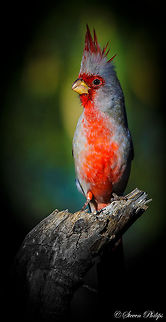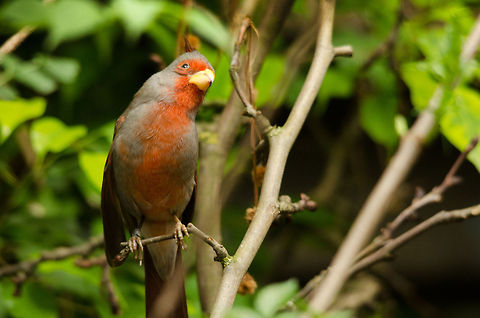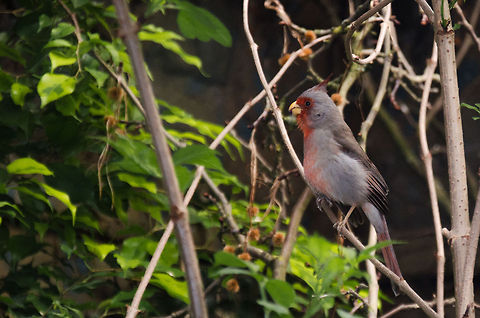
Appearance
The Desert Cardinal is a medium-sized song bird where the length for both sexes is approximately 8.3 in , while the average weight is 0.8–1.5 oz .The most obvious differences between the male Desert Cardinal and the Northern Cardinal are the former's largely coloring. The Desert Cardinal is predominantly brownish-gray with a red breast, a red mask, and a yellow parrot-like bill that is stout and rounded. The females of the two species resemble each other much more closely, but the shapes of their bills are diagnostic. The songs of the two species are identical, though the Pyrrhuloxia's is not quite as loud. This cardinal retains the distinctive long pointed red crest present in all species.

Distribution
The Pyrrhuloxia is a year-round resident of desert scrub and mesquite thickets, in the U.S. states of Arizona, New Mexico, and Texas and woodland edges in Mexico. It occupies the southwestern half of Texas, approximately the southern third of New Mexico, and southeastern region of Arizona. Its range flows further south inhabiting areas from the west to east coast of Mexico north of the Sierra Madre del Sur, Trans-Mexican Volcanic Belt and Isthmus of Tehuantepec, whilst excluding the Sierra Madre Occidental. An individual of the species has reportedly been seen as far away from its dominant range as Costa Mesa, California in Orange County.This cardinal is relatively nonmigratory, though it may occasionally stray slightly north of its usual range. The Pyrrhuloxia prefers habitat along stream beds. In areas where the range of the Pyrrhuloxia and Northern Cardinal overlap, hybridization may occur between them. There seem to be no conflicts between the species as none have yet been reported.

Habitat
The Pyrrhuloxia is a year-round resident of desert scrub and mesquite thickets, in the U.S. states of Arizona, New Mexico, and Texas and woodland edges in Mexico. It occupies the southwestern half of Texas, approximately the southern third of New Mexico, and southeastern region of Arizona. Its range flows further south inhabiting areas from the west to east coast of Mexico north of the Sierra Madre del Sur, Trans-Mexican Volcanic Belt and Isthmus of Tehuantepec, whilst excluding the Sierra Madre Occidental. An individual of the species has reportedly been seen as far away from its dominant range as Costa Mesa, California in Orange County.This cardinal is relatively nonmigratory, though it may occasionally stray slightly north of its usual range. The Pyrrhuloxia prefers habitat along stream beds. In areas where the range of the Pyrrhuloxia and Northern Cardinal overlap, hybridization may occur between them. There seem to be no conflicts between the species as none have yet been reported.In breeding season, songs are used to establish and defend territories. One song has a sharp, clear, wha-cheer, wha-cheer while another is characteristic of a metallic "quink." Females also sing, but they use softer and duller notes. A short cheep or chip is a regular contact call given by both sexes while foraging.
Reproduction
Breeding season for this cardinal usually begins in mid-March, ending in mid-August. As breeding season approaches, territories are established and defended by the male. The male defends the territory by chasing away intruders and from a good vantage point, singing. Where both the Desert and Northern cardinal breeding territories overlap, no inter-species conflicts have been observed.The Desert Cardinal places its nest in dense shrub, often concealed. The nest is small and forms a bowl or cup-like shape made up of grass, twigs or bits of tree bark. Clutches of two to four eggs are most common while the eggs are whitish with specks of green or gray. During incubation period of two weeks, the male brings food to the female. At hatching the chicks are helpless and have a bright yellow bill with red lining around the mouth. The chicks fledge in approximately ten days while both male and female tend to the young. The young bird can wait for up to a month before fully fledging, becoming independent and feeding in large flocks. During this period the bird will achieve complete growth.
Food
The Pyrrhuloxia's diet consists of seeds, fruits and insects. While foraging the Desert Cardinal will snatch insects from trees as well as pick seeds from the stalks of predominantly grasses and like plants. It also seeks out cactus fruit for consumption. This bird is a benefit to cotton fields as it assists in eating populations of cotton worms and weevils. This species of Cardinal also visits bird feeders and in the winter forage in huge flocks, sometimes numbering in the thousands.References:
Some text fragments are auto parsed from Wikipedia.